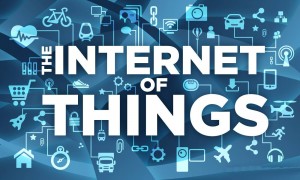The arrival of the Internet changed the way we do business. Now tech watchers say there’s another, equally disruptive technological change that has already begun, and stands to alter the business world once again.
 The coming change is known as the Internet of Things. Alternatively it is called “Cloud of Things” or “real world web.” The concept behind it is that we will rely on actual computers less and less over the next decade as technological interfaces are woven directly into products. Products – from cars to homes to clothing and everything in between – will be constantly gathering and transmitting data to us, and to other products.
The coming change is known as the Internet of Things. Alternatively it is called “Cloud of Things” or “real world web.” The concept behind it is that we will rely on actual computers less and less over the next decade as technological interfaces are woven directly into products. Products – from cars to homes to clothing and everything in between – will be constantly gathering and transmitting data to us, and to other products.
A growing web of connectivity among people, devices and homes will upend the way we interact with the world. Here’s a glimpse into how the changes may affect your life.
“The next generation is not going to understand computers as separate things,” says technology consultant and author Christina Kerley. “When a lightbulb burns out in their house, they’re going to wonder why it didn’t give them a heads-up.”
Tech watchers say 2015 is the year the Internet of Things will start to go mainstream. Indeed, many products already whir constantly in the background of our lives, gathering information on us and the environment. Increasingly, devices will make connections with each other, transferring data and coming to conclusions about how they should operate based on that data. “We are looking at re-instrumenting the physical world – 2015 through 2020 are going to be transformative,” Kerley says.
The tools of this new technology are at a rudimentary stage today, but the potential for game-changing progress, along with disruption, is huge. Think of the Internet of Things in 2015 as analogous to the Internet in 1995. Over time, technology advances have taught us that we could part with certain aspects of our privacy and autonomy. But concerns are mounting that the coming decade may see security breaches and leaks of private information on a scale that was never before possible.
Smart home devices that record and transmit data are already creating a buzz in the marketplace. Perhaps the most familiar such product is the Nest thermostat. Made by a company recently purchased by Google, the Nest thermostat can be controlled from a smartphone but over time learns a household’s schedule. Nest settings can be operated by individual users and integrated with data from institutional hubs like the National Weather Service or a city’s electrical grid. Such devices can serve as a helpful go-between for consumers and municipal smart grids, moderating energy use at peak times to minimize service disruptions. For example, Nest marries its understanding of a household’s habits with data about energy use to make decisions about the best time to run a load of laundry.
Beacon technology is another facet of the new technology. Beacons are small devices, usually powered by Bluetooth, that can be mounted virtually anywhere. They transmit information to nearby receptors, often a mobile device. Beacons can be used to track the movements of people in a home – perhaps to automatically turn lights to a specific preset when a particular person enters the room or to transmit information about the activities of an older adult to a caregiver outside the home.
In Chicago, researchers from the Urban Center for Computation and Data, Argonne National Laboratory and the University of Chicago have partnered with local officials to launch the Array of Things. It’s a network of interactive sensors collecting both passive data, such as weather and air quality, and data about how people are using the area, by measuring ambient noise and counting nearby Wi-Fi and Bluetooth-enabled devices. Researchers plan to make the data freely available as a “public utility.” Tech developers can then use the data to create helpful tools. Imagine an app that combines air quality data with traffic patterns, telling allergy sufferers the best time for a bike ride.
Beacon technology has some clear applications in the retail environment. Because beacons have a long battery life, are portable, and don’t rely on GPS to pinpoint one’s location, they may be able to replace the more expensive and intrusive “geofencing” technology that many stores are using to reach out to nearby customers via their smartphones. Macy’s, Walmart, American Eagle, Walgreens and Hudson’s Bay Co. were among the first retailers to use beacons in stores to offer shoppers special incentives via their phones. The technology has also been applied by companies in the hotel and airline sectors. In January, Facebook announced it would begin testing its new “Place Tips” service in New York, where its beacons – installed in eight iconic shops – will notify nearby users via their Facebook mobile app when they’re near these retail options.
It’s only a matter of time before malls and retail centers consider offering beacon technology to their tenants. Westfield Group, an Australian firm that owns, develops and manages shopping centers in the United States and around the world, has a subsidiary, Westfield Labs, that is currently testing beacon technology for possible use in its locations across the globe.
“You’re going to have retail properties going gaga for this,” says Kerley. “You’ll be able to demonstrate what the foot traffic is like at certain times of day, and what parking is available and just flow that information to them on their smart devices.”
Alex Filip is deputy communications director for the Consumer Product Safety Commission, which is closely monitoring smart product designs. Filip says a potentially unsafe product is just as risky when consumers push the start button as it is when triggered by automation. “Whether you start your car, slow cooker or furnace remotely is not an issue unless it behaves in an unsafe manner,” Filip said. The agency already cautions against operating certain household appliances, including clothes dryers and dishwashers, when no one is home or awake. That warning will continue to apply as smart versions of those products are rolled out.
One common fear for consumers is that their house could be hacked into the same way e-mail and credit card accounts are today. Not only could thieves gain physical access to the home, but they could also be privy to a large volume of information about the owners that might be stored on devices or in the cloud. McCaughey says individual homes would be less appealing to hackers than the prospect of a wider invasion involving “a back door that is known to all hackers,” putting all consumers who own a vulnerable product at greater risk.
At least one example of a breach has prompted action by the Federal Trade Commission. In February 2014, the commission settled charges against TRENDnet Inc., which makes security cameras that can be monitored via the internet. The company had not secured passwords or online feeds of security videos – exposing the private lives of customers – though it had made statements in its marketing that implied the feeds were safe.
“The type of consumer harm we saw in the TRENDnet case . . . feeds concerns about the Internet of Things overall,” Federal Trade Commissioner Maureen Ohlhausen told the U.S. Chamber of Commerce shortly before the final settlement. But the FTC’s “unique set of policy and enforcement tools” can help ensure new technologies safely achieve their promise, she said.
Beyond security, smart devices have other kinks that need working out. In the short term. “This is a fundamental shift in what is going to happen with our industry,” Chad Davis, senior director of digital media at the National Association of Home Builders, said at the International Builders’ Show. Builders attending the show were cautioned by other speakers to watch the development of smart home technology carefully, using the auto industry as a bellwether, and to be cautious about where they hitch their proverbial wagons.
Kerley agrees that there are limitations due to the many competing systems but predicts that will begin to change soon. “2015 will be the year where we have to make the call that there has to be an open system,” she says. “Much like the web uses the same scripting language, that’s going to have to happen.”
Regardless of bumps in the road ahead, early observers of the Internet of Things are optimistic. “Our digital and physical worlds are converging,” Kerley says. She predicts that 75 years from now, historians will look back at 2010–2025 as a time of exponential change. “We’re going through a renaissance,” she says.
 “Prices for commercial properties in highly walkable locations show significantly greater appreciation trends than car-dependent locations,” said RCA Founder Robert White in a release accompanying the announcement. “The findings cut across both urban and suburban locales, large and small markets and each of the office, retail and apartment sectors.”
“Prices for commercial properties in highly walkable locations show significantly greater appreciation trends than car-dependent locations,” said RCA Founder Robert White in a release accompanying the announcement. “The findings cut across both urban and suburban locales, large and small markets and each of the office, retail and apartment sectors.”


